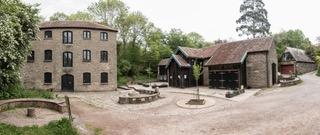In 2023 we were pleased to have discovered that we have Greater Horseshoe and Lesser Horseshoe Bats in our old stable block on the Willsbridge Mill site. These are a more endangered species of bat and, as all bats are a protected species, we have taken great care in our work on site to encourage them. We have been working with Avon Wildlife Trust and the Vincent Wildlife Trust and the latter have been giving us advice on how we should improve the roof space we created when we restored the building.
We were fortunate in early 2024 to be awarded a grant from the Heritage Lottery Fund, and also a contribution from Oldland Parish Council for the work that was recommended to encourage the bats using the roost to increase in number. The Vincent Trust advised us on the construction work needed to the existing loft of our stable block and the need to restrict access, although this building cannot be accessed without permission.
efore we could undertake any work on the loft, we had to obtain a bat licence from Natural England for work in a bat roost and to disturb the bats as little as possible. We were advised that we needed to construct hot/cold voids to offer the bats a varied environment to encourage the bats to breed and partitions so that the bats were disturbed as little as possible.
Bats have a winter roost in an old railway tunnel in the wildlife area managed by Avon Wildlife, known as the Dramway Tunnel. This tunnel is 200 metres away from the stable block and the fact that the bats are using our stable block as a summer roost has been very exciting for both Avon Wildlife and Willsbridge Mill Community Refresh as our respective biodiversity action plans aim to create corridors for species to spread and multiply. We also wanted to include our community, especially children, in the knowledge of the bats’ existence, to understand why they are protected, their natural habitats and ways in which they can enjoy seeing and hearing the bats without disturbing their resting places. Avon Bat Group are planning a number of bat walks around the site and we intend to organise our own bat walks to see the bats at dusk using bat detection equipment to listen to the different echolocation frequencies of different bat species.
The internal work on the barn was completed last month and even in that short period the number of bats has doubled. Experts from the Vincent Trust have advised us that the way the bats are grouping together means that they may well make this their maternity roost. We are considering the installation of heated incubators to give the young the best chance of survival.
We are very grateful to all the organisations that have helped us in this exciting venture.
Pauline Lovell


